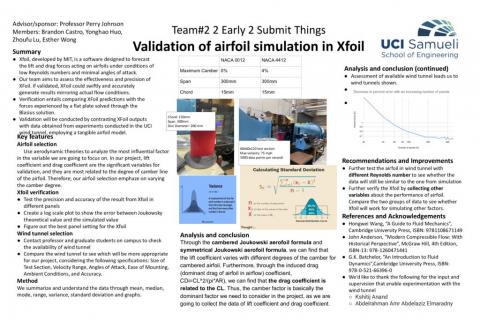2-Validation of a Numerical Prediction Method for Aerodynamics
Background
Numerical analysis tools have gained widespread use by engineers and scientists as a complement to physical experiments for their ease of use and accuracy in modeling real-world environments. As such, it is critical to observe the validity of these simulation tools to better understand the environments which they aim to model and the limitations that apply. This project aims to test and validate XFOIL, a numerical prediction tool for aerodynamical analysis of 2D airfoils, by comparing XFOIL's calculations for lift and drag with experimental data gathered in a wind tunnel. This will be done through a selection of appropriate airfoil geometries to test, as well as the development of a thorough understanding of XFOIL and the design of a rigorous experimental campaign to provide valid data. The details and progress of this project will be documented in a report that will include the assignment of a technical readiness level for XFOIL to be used as an effective modeling tool for aerodynamical analysis.
Goal and Objectives
- Select and verify appropriate types of airfoil (1/20/2024)
- Figure out and verify the best conditions for the Xfoil simulation (2/16/2024)
- Find available and appropriate wind tunnels (2/25/2024)
- Find appropriate airfoil model for wind tunnel (3/15/2024)
- Conduct wind tunnel tests to collect lift and drag data on airfoils (Spring 2024)
- Analyze data and figure out the consistency between Xfoil simulation and reality (Spring 2024)
- Generate a report and identify a technical readiness level (Spring 2024)
More Information
XFOIL website and documentation
Theory reference
- Hongwei Wang, “A Guide to Fluid Mechanics”, Cambridge University Press, ISBN: 9781108671149
- John Anderson, “Modern Compressible Flow: With Historical Perspective”, McGraw Hill, 4th Edition, ISBN-13: 978-1260471441
- G.K. Batchelor, “An Introduction to Fluid Dynamics”,Cambridge University Press, ISBN: 978-0-521-66396-0
Component selection and concept verification
Airfoil selection
Use aerodynamic theories to analyze the most influential factor in the variable we are going to focus on. In our project, lift coefficient and drag coefficient are the significant variables for validation, and they are most related to the degree of camber line of the airfoil. Therefore, our airfoil selection emphaze on varying the camber degree.
Xfoil verification
- Test the precision and accuracy of the result from Xfoil in different panels
- Create a log scale plot to show the error between Joukowsky theoretical value and the simulated value
- Figure out the best panel setting for the Xfoil
Wind tunnel selection
- Contact professor and graduate students on campus to check the availability of wind tunnel
- Compare the wind tunnel to see which will be more appropriate for our project, considering the following specifications: Size of Test Section, Velocity Range, Angles of Attack, Ease of Mounting, Ambient Conditions, and Accuracy.
Analysis Method
We summarize and understand the data through mean, median, mode, range, variance, standard deviation and graphs.
Team Contact(s)
Professor David Copp dcopp@uci.edu
Professor Perry Johnson perry.johnson@uci.edu
Teammates
Brandon Castro bjcastro@uci.edu
Yonghao Huo yonghh1@uci.edu
Zhoufu Lu zhouful@uci.edu
Esther Wong esthersw@uci.edu
Sponsor/Advisor
Perry Johnson perry.johnson@uci.edu


